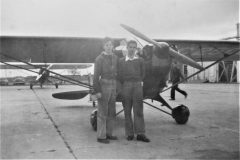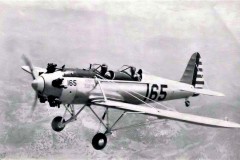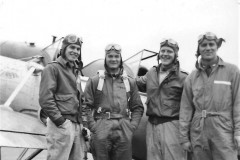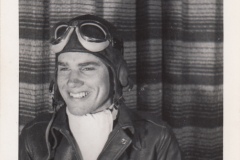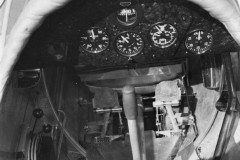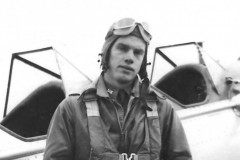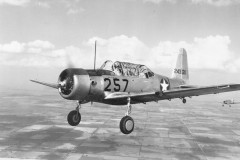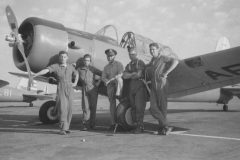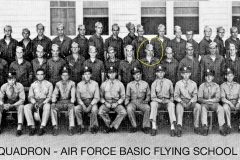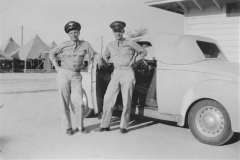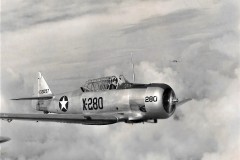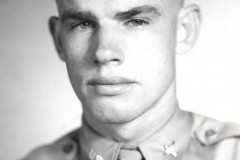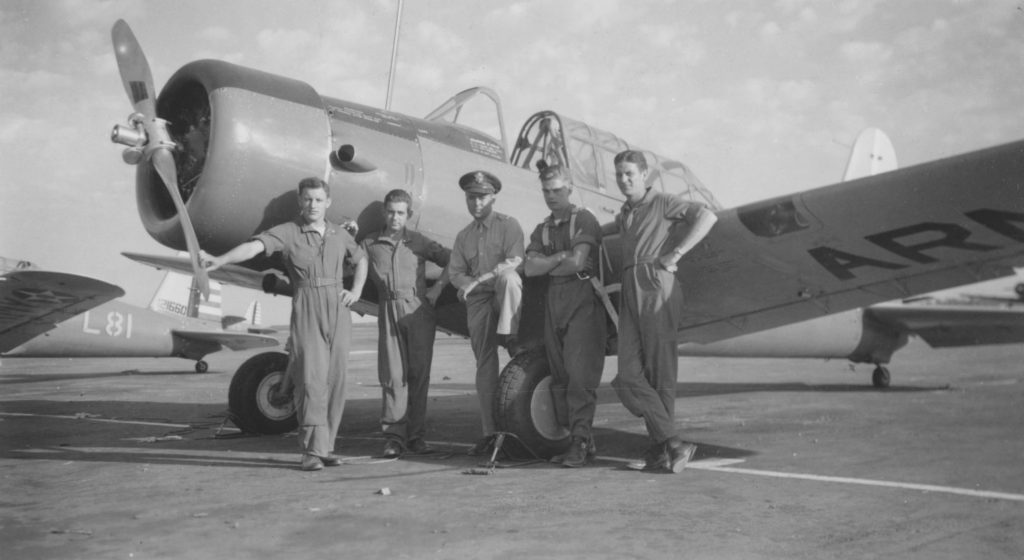
Bud at Minter Field AAF in Basic Flight Training in the PT-13. Instructor 1LT FG Burris with cap, Bud to his left and fellow cadets.
How I became a Pilot
Somewhere in my youth I wanted to fly, it became a passion. I built model aircraft and had aviation photos all over the walls in my room. It was all I could think and dream about. We lived on a farm and the depression hit everyone. Mom and Dad did not have money for me to learn how to fly, so I decided that I would join the military service to learn. I checked out the Navy and the Army programs (we did not have a US Air Force at that time) and found out that I had to have two years of college, be 20 years old, single and in good physical condition (this was the peacetime requirements). So I went to the nearest two year college I could find, Sacramento Jr. College. They had an aeronautics course that qualified me to be an aircraft mechanic and that became my Plan B in case I could not fly.
During the spring of 1941 I became aware of the Civilian Pilot Training Program (CPTP) offered at school. The Government could see that war was likely and this program was to encourage young men to join the service as pilots, although there was no service commitment associated with the program. So for the price of $9.50 for an insurance policy for my parents and their written permission, I got my CAA Private Pilot license at age 19.
The training was at the Sacramento Municipal Airport (now Sacramento Executive airport). This was very handy as the second year of college was taught at the airport.
The training was in a Piper Cub J3 C50 with an advertised 60 HP engine. The Cubs came without radios. My first flight was on 4 March, 1941 and my instructor was Dale Hunter. The course was very structured and I soloed on March 26, 1941 with the required 8 hours of dual instruction. The course was 35 hours, the minimum for the Private Pilots flight test. That was accomplished on March 27, 1941. I was now a certified Pilot
The Sacramento Air Depot was building up there work force and hired our entire class as Junior Aircraft Mechanics. Then on Dec 7, 1941, the Japanese attacked the USA at Pearl Harbor, Hawaii. I was still 19. I had to wait until my 20th birthday on January 13 1941. On my birthday I rushed to the recruiting office on the Base where I worked. After some testing and paper work I raised my right hand and I was on my way. First we had to go to Higley Field, AZ, (later Williams AFB) where we got more physical exams, shots, and clothing. We also learned how to march.
So next it was off to Army Air Corps flight training school. The Army was trying to build up the Air Corps as fast as possible and so they were even hiring civilian schools to teach primary flying. There were three phases Primary, Basic and Advanced flying schools. I was just a kid off the farm and ready to see the world. I thought I surely would go to Texas or Florida, so where do you think I went for Primary flight training? I went to San Diego, CA, to the Ryan School of Aeronautics. We lived in a Motel on a major highway right next to the Lindberg International Airport. There we flew the Ryan PT-22 trainer powered with a 165 HP Kinner engine. It was an open air cockpit low wing monoplane with no radios. Communication with your instructor was via a one way Gosport speaking tube from instructor to student. We had civilian instructors. Since Lindberg International was such a busy airport, the Instructors would fly the aircraft with a student to one of three auxiliary dirt strips in the large mesa north of San Diego. Half the class would be there flying and the other half would be doing academics. Then we would swap so everyone got to fly every day. There were twin brothers instructors there and I recall their last name was Krug. One of them was my Instructor. I started flying on Feb 26, 1942. I received 60 hours of dual and solo flying and left for Basic flight school in May of 1942.
Another chance to travel but in my case only 230 miles closer to home at Minter Field near Bakersfield, CA. This was an Army Air Corps facility with military Instructors.
We started flying again on June 1, 1942. Now we were flying in the Vultee BT-13A basic trainer with a P&W 450 HP engine. It had a closed canopy and we had a radio. We could practice instrument flying under a large hood that covered the rear cockpit. The landing gear was fixed and it had a two position propeller. My Instructor was 1st Lt F. G. Burris and we started flying again. Some new training introduced such as night flying, formation, and instrument flying. We also flew in the Link ground trainer for weather flying. One thing in my memory is how good the food was at Minter Field. They had a hired civilian Chef and he really took care of the Cadets. I believe we got about another 60 hours flying time and moved to our advanced flying school at Luke AAF, AZ. Luke was constructed in 1941 and is still an active Air Force Base. Here we were introduced to the North American AT-6. It was another tail wheel trainer but the landing gear was retractable and it had a constant speed propeller. The canopy was similar to the BT-13 with an instrument flying hood covering the back seat. The engine was a P&W 600HP radial. The flight training was pretty much a rehash of what we did in Basic, but with a more powerful complex aircraft. Near the end of our training we did fly to a remote field near Ajo, AZ and fired the 30 caliber machine gun at ground targets with the AT-6.
So I completed all the training required and on Sept 29, 1942, my Class 42-I received our pilot wings and a commission as a 2nd Lt. in the US Army Air Force. I had a total of 225:40 hours of flying time.
A high percentage of our original class did not complete pilot training due to a lack of flying ability. The Army encouraged the washouts to continue training as navigators and bombardiers. Further, many were killed in aviation accidents. It is a sad statistic of history that we killed more pilots in training than were lost in actual combat during WWII. The pilot training program was conducted on an emergency basis to train 225,000 pilots as fast as possible and don’t let safety get in the way of progress!
Bud Anderson

